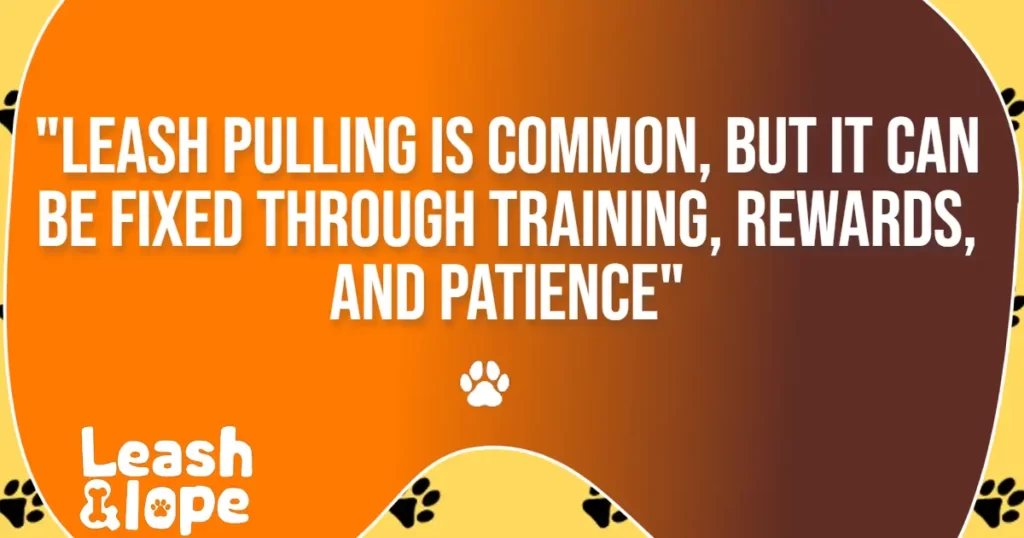When you have a dog that is stronger than you, walks can be difficult due to sudden pulls and strained shoulders. it’s like your dog is taking you on a walk instead you taking your dog with you. who can walk in this situation? You definitely need a pause here to understand why your dog is doing it and what could be the solution. and, regardless of how big and giant your dog is, it can trained into a well-behaved pet.
Well, first things first, there could be several reasons your dog is doing that but one major reason is, your dog is not trained and naturally curious. Curious dogs are a good sign that they respond well but on the other hand it’s problematic when walking.
In this article, we’ll guide you on the recommendations to do in this situation and you can let us know in the comment section what works well for you.
Why My Dog Pulls During Run?

As said earlier, your dog might pull during a run due to having excessive energy, not being properly trained, or just naturally curious breed.
If they remain calm inside the house and show aggression or pull outside, means they are not habitual of loud noises. If you have figured out what causes your dogs to pull, simply avoid it to maintain peaceful walks.
In general, dogs have a habit of sniffing things and exploring new things, and it is very natural. The only thing that can save you from here is clear communication and rewards
What is the Best Gear for Stronger Dogs?
Stronger dogs may require thick and loose leashes. It should be thick enough so it can bear the power of sudden pulls without disturbing you. The ideal leash size would be 6 to 8 feet. Some people recommend using retractable leashes but we dont recommend them as they cause dogs to pull even more.
However, for most dogs flat collars work well and Harnesses works too. Flat collars put the load on the neck when pulled whereas harnesses put pressure on your dog’s chest and shoulders. you might use the combination of both to balance everything if your dog is okay with it.
But, We’ll never suggest using any type of prongs, shock, or any other type of painful solution that can hurt your dogs. and, turn them into aggressive and fearful dogs instead of cheerful canines.
8 Tips for Controlling Strong Dogs

Before moving forward, it’s important to know that training any type of dog is not possible in one day or overnight. All it requires is time, consistency, and discipline. but, if you have achieved that it’ll deserve the effort to turn your pup into a well-behaved dog.
1. Utilize Their Energy Before Walking
if your dog is hyperactive when taking him outside for a walk. the reason it might be a supercharge. Simply, utilize their energy inside the house before taking him on a walk.
This article alternatives to physical exercise for Dogs has all the exercises that can help you.
2. Make A Routine
Training your dog at any time of the day might not give them signal that you are taking him to get trained. Create a pattern, like using any specific type of leah, specific voice command, or special treatment to make their mind that they are about to get trained. In the start keep the sessions small and with the time you can increase the duration.
You can combine this with the first method “Utilizing their energy before training.” as a part of making their routine for work time. These small things will turn into big ones once you keep doing them consistently and help in avoiding leash-pulling behavior.
3. Dont Move Or Move in the Opposite Direction
It’s a simple method that most experts recommend following. Let’s say you are moving in the X direction and your dog is pulling toward to Y or Z position. Just stay there and dont move. Experts name it a “Tree Method”. Show them nothing will happen if they show negative behavior like pulling. they’ll come to investigate why you are not moving and once the leash is loose you can start walking. Doing this repetitive time can make a change.
Sometimes you can do the opposite if your pup wants to go in the Y direction, start moving toward the X direction (the opposite one) once they have listened to you, and never forget the treats
See: How to phase out treats when dog training.
The next time your pup knows by doing this they get a treat if they listen to you, they’ll always listen to you just to get that treat. Always remember, that positive behavior, consistency, and treats are the only way to get whatever you want from the dogs.
A 2013 study in the Journal of Veterinary Behavior found that positive reinforcement-based training was more effective than punishment-based techniques
4. Teach Basic Commands
If your dogs train on the basic commands it might help you stop when the dog is getting out of control. Use the word come when you want them to come. If they follow your command, reward them with a treat.
Use the command NO when you want them to stop. once they’ve listened reward them with a treat. There are different commands commonly used for dogs, like sit, stay, come, wait, quiet, and drop it. Teach them these basic commands by passing through different situations.
If your dog is up to mark on these basic commands, there are high chance that they’ll listen to you when you try to run away.
See: how to train your dog to heel on a leash
5. Keep The Sessions Small And Engaging
I mean you can’t train your dog in one day, it’s very obvious, so better for them to give them time for it. In the start, they might not get the message even what they want to say. but, doing it consistently may clear them what you want them to do or how they can get a treat.
6. Dont Give Treat at The Wrong Time
Always use the treats ONLY when they listen to you. Rewarding them at the wrong time will give them a signal that they can get treated at any time. or you are okay with the leash-pulling behavior.
7. Socializing Your Dog
Teach your dog to communicate with other dogs Try to expose your dogs to other dogs, people, animals, and a variety of environments.
It will help to develop them into better-behaved companions. Introduce them to parks, busy areas, urban places, and different noises. They will become more confident and well-mannered.
8. Building Trust and Strong Bonding
Developing a strong bond with your pet may help you understand their behavior properly. When you have a strong bond with your dog, they will obey you, follow your commands, and never disappoint you during walks.
Conclusion
Firstly, dogs pulling on leash is very natural as they dont know what they are doing. they just want to take their nose whenever they want to explore anything. As a result, they pull the leash and take you with them.
But, no matter how big or strong your dog is, training them is possible. It might require a bit more time. Training time depends upon the dogs’ tolerance level and your teaching method. if you are doing everything right you must start seeing results within 2-3 weeks or max 1 month.
In the end, dont go for any painful solutions like using prolonged leashes that people recommend using, instead promote positive treatment methods instead of negative punishments. Also, never use the treats at the wrong time, once they get to know they are getting more love and appreciation or treats when they are listening to you, they’ll listen. Showing them any type of anger or even shouting at them can disturb them. After all, if things are not in control you can seek professional help.

Dr. Attia Awais -Doctor of Veterinary Medicine (DVM)
(Islamia University Bahawalpur)
M.Phil Microbiology (University of Veterinary and Animal Sciences Lahore)
I am a passionate veterinarian with a deep love for dogs and a strong commitment to their well-being. My expertise in veterinary medicine, combined with my genuine affection for dogs, uniquely qualifies me to write informative and insightful articles about these beloved companions. Whether it’s topics on dog health, behavior, or care, I’m dedicated to providing valuable insights to fellow dog lovers.
AREAS OF Expertise
- Dog and Wellness
- Canine Behavior and Training
- Nutrition and Dietary Requirements for Dogs
- Infectious Disease Management in Dogs

